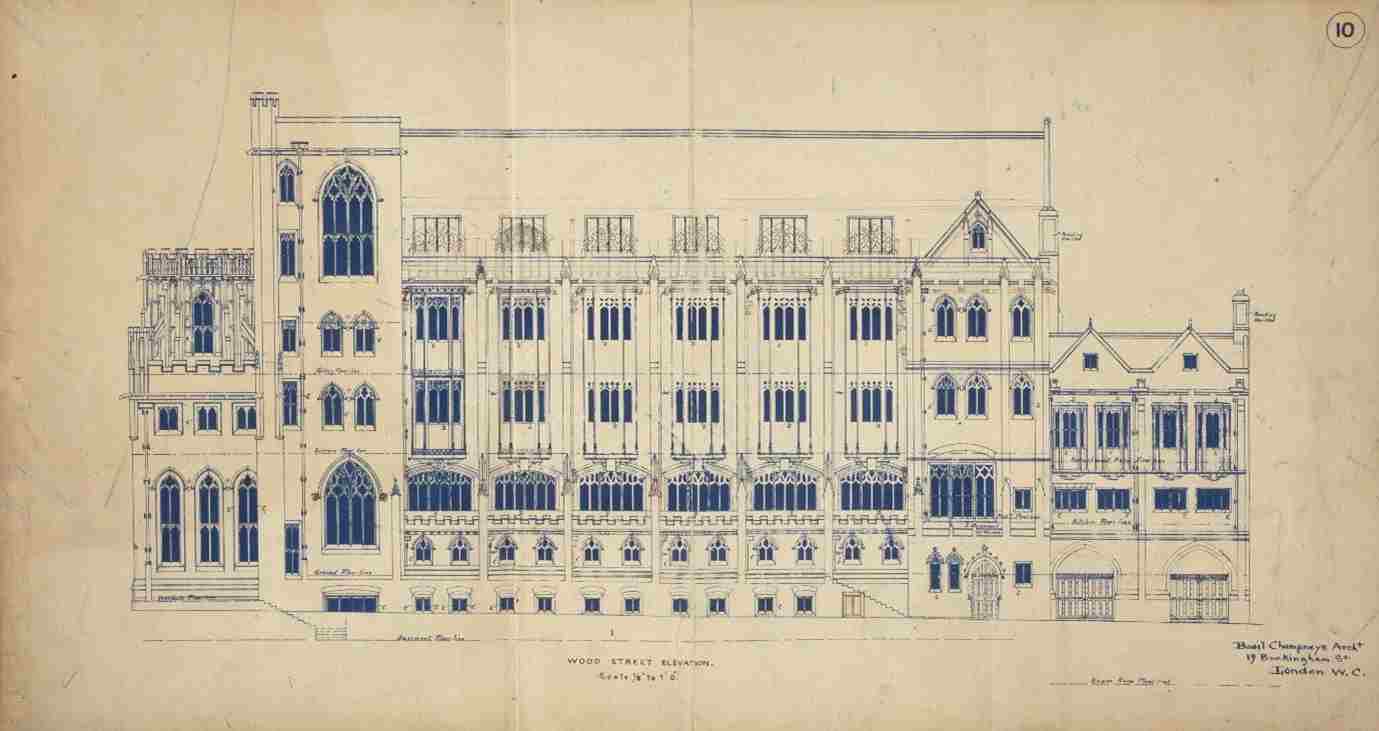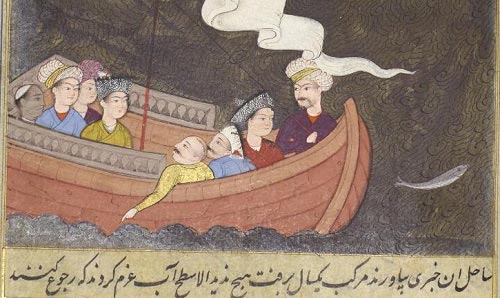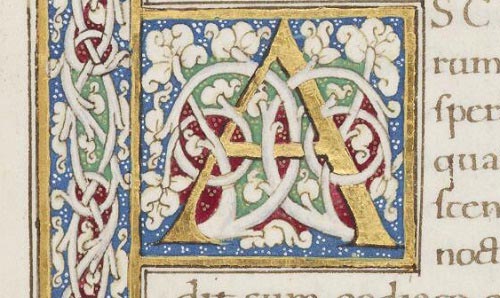
History of Art and Architecture Collections
The Library holds a wealth of material across all collections relevant to the study of both the history of art and architecture.

The richly illuminated manuscript collections are of international significance; our archives contain the papers of many artists, art critics and architects; and the Rylands Library Archive holds information about the design of the Library itself.
In addition, the Library’s holdings of printed materials relating to art and architecture are outstanding; they range from early 15th-century block-books to finely illustrated books and designer bookbindings of the late 20th century. The Rylands also has exceptional visual collections that comprise photography collections, fine art works, decorative art works and objects.
Manuscript and archive material
The Rylands possesses excellent collections of Western (European), Jewish, Near Eastern and Asian manuscripts. Most of these collections include fine examples of calligraphy and book art, either in the form of illustrated and illuminated manuscripts, or of material culture in exquisite original bindings, medieval jewelled book covers, and ivory carvings.
The Library also has numerous manuscript and archival collections relating to 19th-century art history, and especially to the Pre-Raphaelite circle, holding papers of the artist William Holman Hunt, the artist and collector Charles Fairfax Murray, the writer and critic John Ruskin, the critic and connoisseur Marion Harry Spielmann, and the Manchester artist Robert Crozier. The papers contain substantial exchanges of correspondence between figures that include Edward Burne-Jones, D.G. Rossetti, W.M Rossetti, William Morris, George F. Watts, Frederic Lord Leighton, and Charles Eastlake, the first Director of the National Gallery. In addition, the extensive archive of Walter Crane, illustrator, designer and artist, is a significant resource for students of 19th-century art and design.
Amongst the 20th-century material, we count the papers of the artist Frank Owen Salisbury, who specialized in portraiture and in historical and religious subjects; Margaret Pilkington, wood-engraver and Honorary Director of the Whitworth Art Gallery; the art writer and educator Alan Freer; commercial artist and calligrapher Alan Tabor; and Stephen Raw, contemporary letter artist. Other material of potential interest to art historians occurs in drama- and film-related collections such as the papers of Basil Dean, Robert Donat and Stephen Joseph, which contain original artwork, photographs, and set and costume designs.
Also well represented in the collections are post-World War II avant garde international art and ‘counter cultural’ movements. Art works, ’zines and artists books survive in the collections of dom sylvester houēdard, Li Yuan-chia and Jeff Nuttall. These archives are rich resources that link visual and literary cultures, which offer opportunities for interdisciplinary study.
The papers of distinguished art historian Professor Marcia Pointon are an important source for studies of the historiography of art history in the late 20th and early 21st centuries, documenting the development of the academic discipline of art history and the changing nature of scholarly communications during this period.
The Library holds several architectural archives including the Manchester Society of Architects, the Society of Architectural Historians of Great Britain and the University of Manchester’s School of Architecture Archive. We also hold personal papers relating to distinguished architects and town planners, including the papers of: Manchester-based architect Sir Hubert Worthington; Raymond Unwin, one of the leading architects and town planners of the first half of the 20th century; and Alfred Darbyshire, best known for his work on theatres. The Edward Freeman Papers contain thousands of drawings of churches and correspondence with Sir George Gilbert Scott and other architects.
Finally, the archives of the John Rylands Library contain information on the design and construction of this internationally important Grade I listed building. Students of country-house architecture, landscape design and garden history will also find useful material among the Muniment and Charter Collections. For the example, the Legh of Lyme Muniments contain architectural drawings of Lyme Hall by Giacomo Leoni.
Printed resources
The Incunabula Collection contains block-books and pre-1500 publications, which combine woodcuts with movable type. However, the Library’s holdings of illustrated books range through the whole history of printing, representing the work of hundreds of artists and illustrators.
European prints and visual print culture are excellently represented in the Rylands collections. Covering a spectrum of subjects, our prints provide examples of a range of different techniques including relief, intaglio, planographic and screen printing. They date from the 15th century to the present and include works by Nicolas Poussin, Claude Mellan, William Hogarth, William Blake and Ian Hamilton Finlay. The Holtorp Collection, assembled by the 19th-century collector and designer Hiero von Holtorp, is an especially rich source for the study of Renaissance prints and contains works by Northern and Italian masters including, Albrecht Durer, Hans Burgkmair, and Andrea Mantegna.
The golden age of the English Private Press Movement in the 1890s corresponded with the building and foundation of The John Rylands Library. This enabled the establishment of a rich collection of the earliest and most important presses, including all fifty-three publications of William Morris’s Kelmscott Press. Many private press books are illustrated, and the collection provides a complete conspectus 20th-century wood-engraving in Britain, including work by artists such as Eric Gill, Enid Marx, Agnes Miller Parker and Eric Ravilious.
In addition, the library holdsmany facsimile editions and standard reference works on antiquities, fine art, engravings, numismatics, furniture, stained glass, ceramics, textiles and costume.
Students of architecture will find a large collection of historic surveys and treatises, both English and Continental, including works on the Classical, Medieval, Renaissance, Baroque, Georgian and Victorian periods. Authors include Vitruvius, Alberti, Palladio, Adam, Soane and Repton. In addition to works on ‘bricks and mortar’ architecture, there are texts of interest for studies in landscape history and land use, garden history, death and the afterlife, the functioning of cities and concepts of space and ritual. The Temple Collection is particularly rich in books on landscape and garden history.
Urban design and development, particularly of Manchester and the North West of England, is well documented in our Map Collection. Included in the collection are large-scale historical town plans by William Green and Joseph Adshead, as well as detailed Ordnance Survey plans dating from 1848 to the present day.
List of collections (A-L)
Physical collections (A-L)
- Arabic Manuscripts
- Architectural Printed Works
- Armenian Manuscripts
- Booker and Mills Map Collections
- British Victorian Photography Collection
- Carcanet Press Archive
- Children's Printed Collection
- Chinese Collection
- Alvin Langdon Coburn Photography Collection
- Walter Crane Archive
- Robert Crozier Collection
- Alfred Darbyshire Collection
- Robert Donat Archive
- Anthony Dowd Bindings Collection
- Dutch Manuscripts
- English Manuscripts
- Edward Freeman Papers
- Edward Freeman Printed Collection
- Allen Freer Book Collection
- Allen Freer Papers
- French Manuscripts
- German Manuscripts
- Greek Manuscripts
- Hebrew Manuscripts
- Hiero von Holtorp Collection
- dom sylvester houédard Book Collection
- dom sylvester houédard Papers
- Illustrated Books
- Incunabula Collection
- Italian Manuscripts
- Japanese Collection
- George Johnson Wood-Engraving Collection
- Stephen Joseph Papers
- Latin Manuscripts
- Li Yuan-chia Archive
List of collections (M-W)
Physical collections (M-W)
- Manchester Geographical Society Photographic Slides Collection
- Manchester Society of Architects Archive
- Charles Fairfax Murray Papers
- Norman Nicholson Papers
- Jeff Nuttall Papers
- Martin Parr Photography Collection
- Persian Manuscripts
- Photography Collection
- Margaret Pilkington Papers
- Marcia Pointon Papers
- Private Press Collection
- Stephen Raw Papers
- Dorothy Richardson Papers
- William Michael Rossetti Papers
- John Ruskin Papers
- John Ruskin Printed Works
- John Rylands Library Archive
- Frank Owen Salisbury Papers [Archive]
- Frank Owen Salisbury Papers
- Samaritan Manuscripts
- Society of Architectural Historians of Great Britain Archive
- South-East Asian Manuscripts
- Spielmann Collection
- Syriac Manuscripts
- Alan Tabor Calligraphy Collection
- Nigel Temple Book Collection
- Tregaskis Bindings Collections
- Turkish Manuscripts
- Sir Raymond Unwin Papers
- University of Manchester, School of Architecture Archive
- George H. Viner Bookplate Collection
- Mark Warner Photography Collection
- Wedgwood Correspondence
- Whitworth Art Gallery Archive
- Sir Hubert Worthington Papers
Digital collections
- Bible Illustrations in Manchester Digital Collections
- Broadside Ballads in Manchester Digital Collections
- Chinese Collections in Manchester Digital Collections
- Dante in Manchester Digital Collections
- Early Photographic Albums in Manchester Digital Collections
- Gaster Amulets in Manchester Digital Collections
- Hebrew Manuscripts in Manchester Digital Collections
- Japanese Maps in Manchester Digital Collections
- Latin Manuscripts in Manchester Digital Collections
- Magic, Monsters and Macabre in Manchester Digital Collections
- Mapping Manchester in Manchester Digital Collections
- Middle English Manuscripts in Manchester Digital Collections
- Papyrus to Print in Manchester Digital Collections
- Persian Manuscripts in Manchester Digital Collections
- Petrarch in Manchester Digital Collections
- Photo Jewellery in Manchester Digital Collections
- Rag Rag in Manchester Digital Collections
- Letters of John Ruskin in Manchester Digital Collections
- Syriac Manuscripts in Manchester Digital Collections
- Women in Wartime in Manchester Digital Collections
Further information
Related subject pages
- Africa Collections
- Ahmed Iqbal Ullah RACE Centre Collections
- British Pop Archive
- Classics and Ancient History Collections
- East Asia Collections
- English Literature Collections
- European Literature Collections
- History of the Book Collections
- Jewish Studies Collections
- Maps, Travel and Discovery Collections
- Middle East Collections
- Performing Arts Collections
- South Asia Collections
- Visual Collections
- Western European Manuscript Collections

Exploring subject areas
An overview of our Special Collections, including information about the background and history of our holdings.

Special Collections A-Z
Explore the Special Collections through the collection names and descriptions using our searchable A-Z tool.
